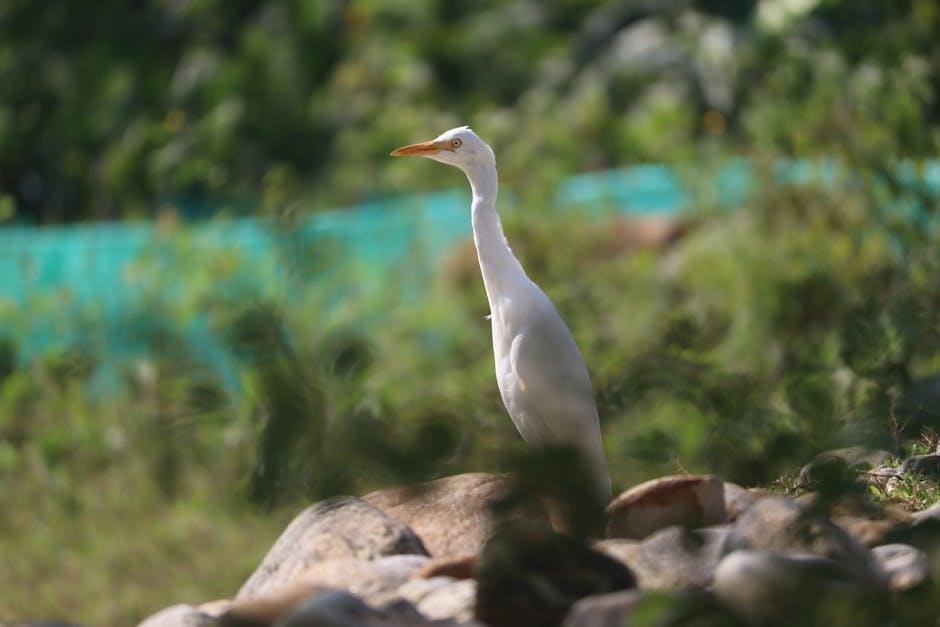Arthur Spiderwick’s Field Guide is a captivating compendium detailing fantastical creatures like boggarts, pixies, and more․ Authored by Arthur Spiderwick, it bridges the human and faerie worlds, offering an essential guide for those who believe in magic and its wonders․
Overview of the Field Guide
Arthur Spiderwick’s Field Guide is a comprehensive guide to the fantastical world, detailing various magical creatures and their characteristics․ It serves as a bridge between the human and faerie realms, offering insights into the Invisible World․ Authored by Arthur Spiderwick, the guide is based on his extensive sketches and investigations․ It includes information about boggarts, changelings, pixies, goblins, and other creatures, providing detailed descriptions and illustrations․ The guide is part of the Spiderwick Chronicles series by Tony DiTerlizzi and Holly Black․ It is designed to spark imagination and curiosity in children, encouraging them to explore and believe in the magical world around them and its wonders․ The Field Guide has become a beloved resource for understanding the fantastical world․
The Significance of the Spiderwick Chronicles
The Spiderwick Chronicles hold a special place in children’s literature, captivating readers with tales of magic and adventure․ Authored by Tony DiTerlizzi and Holly Black, the series introduces the Grace children, who uncover a hidden world of faeries․ Arthur Spiderwick’s Field Guide is central to their journey, serving as a key to understanding the Invisible World․ The Chronicles have become a cultural phenomenon, inspiring adaptations and sparking imaginations worldwide․ They emphasize the importance of curiosity, bravery, and the belief in the magical․ The series has resonated with readers of all ages, making it a timeless and cherished collection of stories that celebrate the power of storytelling and the allure of the unknown․
Arthur Spiderwick as the Author
Arthur Spiderwick is a meticulous and dedicated researcher of the Invisible World, renowned for his detailed sketches and investigations․ His field guide serves as a testament to his lifelong passion for documenting fantastical creatures and their habitats․ Spiderwick’s work is characterized by its accuracy and depth, offering readers a comprehensive understanding of the magical realm․ The guide is not only a scientific endeavor but also a labor of love, reflecting his fascination with the unseen world․ Through his writings, Spiderwick aims to enlighten and inspire those who seek to explore the fantastical world, making his work a cornerstone of faerie lore and a cherished resource for believers of all ages․

The Structure of the Field Guide
Arthur Spiderwick’s Field Guide is meticulously organized, detailing fantastical creatures and their habitats․ Each entry includes sketches, behaviors, and habitats, making it a user-friendly, comprehensive resource for enthusiasts․
Organization of the Guide
Arthur Spiderwick’s Field Guide is meticulously organized into clear categories, each focusing on specific types of creatures․ Entries are detailed with descriptions, behaviors, habitats, and Arthur Spiderwick’s original sketches․ The guide is designed to be user-friendly, making it easy for both children and enthusiasts to navigate․ It likely includes an index or table of contents for quick access․ Each section builds logically, starting from an introduction to the fantastical world, moving through different creature types, and ending with practical advice․ This structure ensures that readers can efficiently explore and understand the magical world around them․
Key Features and Illustrations
Arthur Spiderwick’s Field Guide is renowned for its detailed and enchanting illustrations, which bring the fantastical world to life․ Each creature is depicted with precision, showcasing their unique characteristics․ The guide includes Arthur Spiderwick’s original sketches, notes, and observations, offering an authentic glimpse into his investigations․ The illustrations are atmospheric, with a mix of sweeping landscapes and close-up details, making the magical world feel real․ Practical effects and realistic depictions enhance the guide’s appeal․ Brief yet informative text accompanies each illustration, providing insights into the creatures’ behaviors and habitats․ This blend of art and knowledge makes the guide both visually captivating and intellectually enriching, appealing to readers of all ages who seek to explore the Invisible World․
Arthur Spiderwick’s Sketches and Investigations
Arthur Spiderwick’s sketches are meticulously crafted, capturing the essence of each creature he encountered․ His investigations delve deeply into the behaviors, habitats, and characteristics of faeries, boggarts, and other beings․ The guide is a testament to his dedication, offering a comprehensive understanding of the Invisible World․ Spiderwick’s detailed notes and observations provide readers with practical insights, making the guide invaluable for those exploring the magical realm․ His work bridges the human and faerie worlds, fostering a sense of wonder and discovery․ The sketches are not only artistic but also informative, reflecting Spiderwick’s passion for uncovering the secrets of the fantastical world․

Creatures of the Fantastical World
The guide reveals a diverse array of magical beings, from mischievous pixies to mysterious boggarts, each with unique traits and roles in the Invisible World․
Boggarts: Characteristics and Behavior
Boggarts are mysterious, shape-shifting creatures from the Invisible World․ They thrive in damp environments and are known for their mischievous and often malevolent behavior․ According to Arthur Spiderwick’s guide, boggarts can take on various forms to deceive or frighten humans․ Their ability to adapt to different surroundings makes them particularly elusive․ Spiderwick’s sketches reveal their affinity for dark, secluded places like swamps or abandoned houses․ Boggarts are drawn to fear, feeding on the negative emotions of those around them․ Despite their troublesome nature, they are fascinating subjects in the study of faerie creatures, offering insights into the complexities of the magical realm․
Changelings: Their Role in Faerie Society
Changelings are human children replaced by faeries, often as part of a bargain or to strengthen faerie ties with the mortal world․ According to Arthur Spiderwick’s guide, these children are integrated into faerie society, where they serve various roles, from spies to wards․ Changelings possess unique abilities that bridge both worlds, making them invaluable to the faeries․ Their presence in faerie courts often influences political dynamics, as they are seen as symbols of connection between humans and the Invisible World․ Despite their resilience, changelings often struggle with their dual identities, torn between their human origins and their faerie upbringing․ This duality makes them both fascinating and tragic figures in the fantastical realm․
Pixies: Mischievous Beings of the Invisible World
Pixies are small, mischievous creatures known for their love of pranks and thievery․ According to Arthur Spiderwick’s guide, they are attracted to shiny objects and sweet treats, often stealing them from humans․ Pixies are quick and agile, with a penchant for causing trouble, but they can also be helpful if treated kindly․ Their habitats are typically near flowers or in gardens, where they thrive in nature’s embrace․ While they are not inherently evil, their troublesome antics can lead to chaos for those who encounter them․ Pixies embody the whimsical and unpredictable nature of the Invisible World, making them both fascinating and formidable beings․ Their connection to the natural world highlights their unique place in faerie society․
Goblins: Their Nature and Habitat
Goblins are small, grotesque creatures known for their mischievous and often troublesome behavior․ According to Arthur Spiderwick’s guide, they are typically found in dark, damp environments such as caves or abandoned ruins․ Goblins thrive in secluded areas where they can avoid detection by humans․ Their nature is inherently thieving, and they have a strong affinity for shiny objects, often hoarding them in their lairs․ Despite their unpleasant appearance and habits, goblins are not inherently evil but can be dangerous if provoked․ Their connection to the darker corners of the Invisible World makes them fascinating yet cautionary figures in the faerie realm․ Understanding their habits and habitats is essential for those exploring the fantastical world․
Sprites: The Guardians of Nature
Sprites are delicate, ethereal beings deeply connected to the natural world․ According to Arthur Spiderwick’s Field Guide, they are often found near water sources, such as rivers, lakes, or waterfalls, where they serve as guardians of aquatic ecosystems․ Sprites are known for their iridescent wings and translucent appearance, blending seamlessly into their surroundings․ Their role involves maintaining balance in nature and protecting it from harm․ They are typically shy but can be benevolent towards those who respect the environment․Sprites communicate through soft, melodic sounds and are often seen fluttering around flowers or glimmering water․ Their connection to nature makes them vital to the Invisible World, ensuring the beauty and health of their habitats remain untouched․
Hobgoblins: Their Differences from Goblins
Hobgoblins and goblins, while similar in mischief, are distinct creatures in Arthur Spiderwick’s Field Guide․ Hobgoblins are often larger, more cunning, and inclined toward trickery, whereas goblins are smaller and more chaotic․ Hobgoblins prefer shiny objects and clever pranks, thriving in environments where they can outwit others․ Unlike goblins, who are openly disruptive, hobgoblins operate with subtlety, often blending into human surroundings unnoticed․ Their love for trickery and cleverness makes them unique in the Invisible World, as they are both feared and admired for their intelligence․ Despite their differences, both creatures share a mischievous nature, adding complexity to the fantastical realm described by Spiderwick․
Dragons: Mythical Creatures in the Fantastical World
Dragons, as depicted in Arthur Spiderwick’s Field Guide, are majestic creatures of immense power and beauty․ These beings are characterized by their large size, shimmering scales, and the ability to breathe fire․ Unlike goblins or hobgoblins, dragons are rare and elusive, often dwelling in remote, hidden realms․ Their intelligence and strength make them both revered and feared in the Invisible World․ Dragons are known to hoard treasures, not just for wealth but to protect magical objects from falling into the wrong hands․ Despite their fearsome reputation, they are also guardians of ancient secrets, playing a vital role in maintaining balance within the fantastical world․ Their existence, though challenging to confirm, captivates the imagination of many who seek magic around them․

The Magical World Around Us
The magical world, as revealed in Arthur Spiderwick’s guide, is surprisingly close, offering glimpses of enchantment hidden just beyond our everyday reality, full of thrilling secrets․

The Proximity of the Faerie World
The faerie world, as documented in Arthur Spiderwick’s Field Guide, exists in close proximity to our own, often hidden in plain sight․ This magical realm is not distant or unreachable but intertwined with our everyday environments․ The guide reveals that fantastical creatures and places can be found in forests, gardens, and even within the walls of old houses․ The faeries’ world is so near that it requires only a keen eye and a believe to uncover its presence․ This closeness emphasizes the idea that magic is not something far-off but an integral part of our surroundings, waiting to be discovered․
The Invisibility of the Fantastical Realm
The fantastical realm described in Arthur Spiderwick’s Field Guide remains invisible to most humans, hidden by powerful magical forces․ These enchantments prevent the unseen world from being detected by those unaware of its existence․ The guide explains that only those with a keen sense of awareness and belief in the magical can glimpse this hidden reality․ Iron, a natural inhibitor of magic, further obscures the fantastical world, making it even more concealed from the untrained eye․ This invisibility adds to the allure and mystery of the faerie world, highlighting its exclusivity and the special nature of those who can perceive it․ The Field Guide serves as a vital tool for those seeking to uncover this invisible realm․
The Role of Iron in the Magical World
Iron plays a significant role in Arthur Spiderwick’s Field Guide as a natural inhibitor of magic․ It disrupts magical energies, making it difficult for faeries and other creatures to perform spells or maintain enchantments․ This property makes iron a vital tool for humans seeking to protect themselves from malevolent beings․ The Field Guide highlights how iron repels harmful entities like goblins and boggarts, providing practical advice for safeguarding one’s surroundings․ Its abundance in the human world also explains why the fantastical realm remains hidden, as iron’s presence weakens magical barriers․ Understanding iron’s role is crucial for navigating the invisible world, offering both protection and insight into the delicate balance of magic and reality․ This knowledge empowers believers to coexist with the fantastical world more effectively․

The Grace Children and Their Adventures
The Grace children—Jared, Simon, Mallory, and Helen—uncover the magical world through Arthur Spiderwick’s Field Guide․ Their adventures reveal the hidden realm of faeries and fantastical creatures, sparking wonder and danger․
The Discovery of the Field Guide
The Grace children stumbled upon Arthur Spiderwick’s Field Guide in the attic of their new home, uncovering a hidden world of faeries and magical creatures․ This leather-bound book, filled with Arthur’s meticulous sketches and notes, revealed the Invisible World’s secrets, offering insights into the lives of boggarts, pixies, and other fantastical beings․ The guide became their key to understanding and navigating this unseen realm, providing practical advice for interacting with its inhabitants․ Its discovery not only sparked their adventures but also reignited the magic that lay just beyond the edge of everyday life, making it an essential companion for any believer in the extraordinary․

Jared, Simon, Mallory, and Helen’s Roles
Jared, Simon, Mallory, and Helen Grace each played distinct roles in unraveling the mysteries of Arthur Spiderwick’s Field Guide․ Jared, the cautious leader, often acted as the voice of reason, while Simon’s curiosity and knack for nature helped bridge the human and faerie worlds․ Mallory, with her bravery and knowledge of folklore, protected her siblings from harm․ Helen, though absent, left a mysterious legacy that influenced their journey․ Together, they complemented each other’s strengths, contributing uniquely to their adventures and the understanding of the Invisible World․ Their shared determination to uncover the truth about the fantastical realm highlighted their individual and collective importance in the story․ Their roles were pivotal in navigating the magical world around them․
Their Contributions to the Understanding of the Invisible World
The Grace children’s adventures significantly expanded the understanding of the Invisible World․ By discovering and utilizing Arthur Spiderwick’s Field Guide, they uncovered secrets about faeries, boggarts, and other magical creatures․ Their experiences provided practical insights into the behaviors and habitats of these beings, enriching the knowledge passed down by Spiderwick․ Through their bravery and curiosity, they revealed how the faerie world interacts with the human realm, highlighting the importance of belief and caution․ Their contributions not only preserved Spiderwick’s legacy but also inspired others to explore and appreciate the magical world around them, fostering a deeper connection between the visible and invisible realms․

The Impact of the Field Guide
Arthur Spiderwick’s Field Guide has inspired countless believers in magic, sparking curiosity about the invisible world․ It serves as a timeless guide for exploring the fantastical․
Encouraging Belief in Magic
Arthur Spiderwick’s Field Guide plays a pivotal role in fostering belief in magic among readers, especially children․ By detailing the existence of faeries, boggarts, and other mythical creatures, it creates a sense of wonder and enchantment․ The guide’s meticulous descriptions and illustrations make the fantastical world feel real and accessible, encouraging readers to embrace the idea that magic is just beyond the edge of everyday reality․ This belief not only captivates the imagination but also inspires curiosity about the unseen worlds around us, making it a cherished companion for those who seek to uncover the magic in their own lives․

Sparkling Curiosity About the Unknown
Arthur Spiderwick’s Field Guide ignites curiosity about the unseen world, revealing the magic that surrounds us․ With vivid descriptions of boggarts, pixies, and other creatures, it invites readers to explore the Invisible World․ The guide’s blend of sketches and insights sparks a sense of adventure, encouraging readers to look beyond the ordinary․ By detailing the habits and habitats of fantastical beings, it fosters a deeper appreciation for the mysteries of nature and the supernatural․ This curiosity not only enriches imagination but also inspires readers to observe their surroundings with a fresh perspective, uncovering the hidden wonders that Arthur Spiderwick so meticulously documented․
Practical Advice for Exploring the Invisible World
Arthur Spiderwick’s Field Guide offers invaluable advice for exploring the Invisible World, guiding readers on how to observe and interact with its magical inhabitants․ The guide emphasizes the importance of caution, noting that faeries and other creatures can be unpredictable․ It advises readers to remain stealthy and respectful when encountering these beings․ Tips include avoiding iron, which repels magical creatures, and using observation skills to identify habitats․ The guide also warns against provoking dangerous entities like goblins or boggarts․ By following Spiderwick’s insights, readers can safely navigate the fantastical world, uncovering its secrets while minimizing risks․ This practical wisdom makes the Invisible World accessible and sparks curiosity in young explorers․

Legacy and Cultural Influence
Arthur Spiderwick’s Field Guide has become a beloved resource, inspiring fans and influencing fantasy literature․ Its popularity endures, fostering a community of enthusiasts and sparking creativity․
Popularity and Reception of the Guide
Arthur Spiderwick’s Field Guide has garnered widespread acclaim for its enchanting portrayal of the fantastical world․ Readers, particularly children, have embraced its magical insights and vivid illustrations․ The guide’s popularity stems from its ability to spark imagination and curiosity about unseen realms․ As part of the Spiderwick Chronicles, it has become a beloved companion for fans of the series․ Critics praise its detailed descriptions and artistic sketches, making it a must-have for fantasy enthusiasts․ Its success has led to its inclusion in bestseller lists, further cementing its place in children’s literature․ The guide’s enduring appeal lies in its timeless themes of magic and discovery․
Adaptations and Media Appearances
Arthur Spiderwick’s Field Guide has been brought to life through various media adaptations, most notably in the film adaptation of The Spiderwick Chronicles; The movie captures the essence of the guide, showcasing its magical world with stunning visuals and practical effects․ The guide itself plays a central role in the story, aiding the Grace children in their adventures․ Additionally, the guide has inspired video games, further immersing fans in its fantastical realm․ These adaptations have introduced the guide to a broader audience, enhancing its popularity and cementing its place in modern fantasy culture․ The guide’s timeless appeal continues to inspire new generations through these multimedia interpretations․
Fan Creations Inspired by the Guide
Arthur Spiderwick’s Field Guide has sparked a wave of creativity among fans, inspiring countless artistic interpretations and imaginative projects․ Enthusiasts have created intricate fan art, depicting the fantastical creatures and scenes described in the guide․ Cosplay designs based on characters like the Grace children and mythical beings have also gained popularity․ Additionally, fan fiction stories expand on the guide’s lore, exploring new adventures in the Invisible World․ Crafters have even produced replicas of the guide, complete with handwritten notes and sketches, adding a personal touch to the magical universe․ These creations reflect the deep connection fans feel with Spiderwick’s work, showcasing the guide’s enduring influence on creativity and imagination․
Arthur Spiderwick’s Field Guide is a timeless treasure, revealing the magic around us․ It captivates believers, offering insights into hidden worlds, making the invisible visible․
Final Thoughts on the Field Guide
Arthur Spiderwick’s Field Guide is a beloved treasure, offering insights into the magical world․ Its detailed descriptions and illustrations captivate readers, inspiring belief in the unseen․ The guide’s legacy endures, sparking curiosity and wonder, making it a timeless companion for those exploring the fantastical․
The Enduring Appeal of Arthur Spiderwick’s Work
Arthur Spiderwick’s Field Guide captivates readers with its rich, imaginative world, blending detailed sketches and insightful descriptions․ Its enduring appeal lies in its ability to inspire belief in magic, making the fantastical feel real․ The guide’s cross-generational charm lies in its storytelling, visuals, and practical advice, fostering curiosity and wonder․ Its popularity extends beyond books, influencing films and fan creations, cementing its legacy as a timeless treasure in children’s literature․
